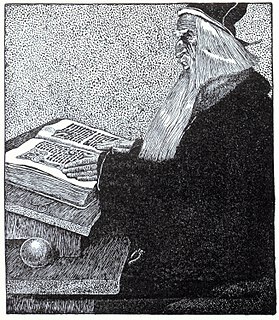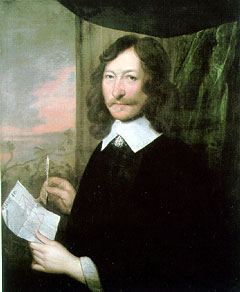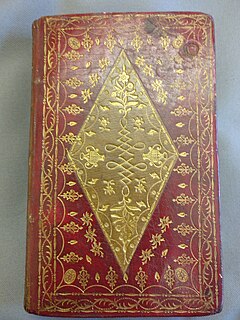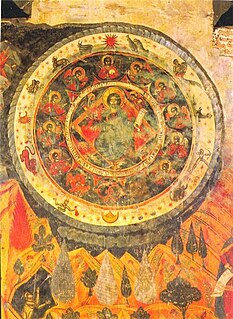
Rider's British Merlin was one of the earliest almanacs to be published, issued from 1656 until at least 1830.

Rider's British Merlin was one of the earliest almanacs to be published, issued from 1656 until at least 1830.
The almanac contained the calendar, weather, and astronomical and astrological information that a typical almanac of the period would contain. The pages for each month of the year were accompanied by advice on what, and what not to eat and drink, and otherwise how to keep in good health. There were horticultural notes with abundant attention paid to herbs, fruit and vegetables.
The lengthiest sections of this little book listed annual fairs in England and Wales of fixed and moveable date. The first would generally be associated with a saint's day, while the second would be of the type "second Monday in October". This list of town names and dates represented important information in the days before Agricultural Advisers, Trade Fairs and Job Offices, when the fairs played an important role not only in buying and selling, but also in exhibiting innovations in husbandry, in information exchange and in the hiring of labour.
It is generally held that Cardanus Rider is a pseudonym, and near-anagram: the letters rearrange as Ric_ard Saunder_. Richard Saunders was an English physician and astrologer, born in 1613, and who died (sources differ) either in 1675, 1687, or 1692.
The National Archives in London hold a book by Saunders on palmistry, with horoscopes; also attributed to him is The Astrological Judgment and Practice of Physick [2] , published in 1677, although the fact that it includes charts from as early as 1616 to 1618 has led doubts to be cast on the actual authorship. Be that as it may, its subject matter was dear to the heart of "Cardanus Rider"; it stands as one of the earliest astro-medical treatises in the English language. Using the terminology of his day, the writer speaks of humours and winds, of conditions hot, cold or dry, of the cholerick and melancholy, of illnesses produced by the planets in the various signs of the zodiac, when to administer medicines based on planetary hours, and much more. [3]

Astrology is a pseudoscience that claims to discern information about human affairs and terrestrial events by studying the movements and relative positions of celestial objects. Astrology has been dated to at least the 2nd millennium BCE, and has its roots in calendrical systems used to predict seasonal shifts and to interpret celestial cycles as signs of divine communications. Many cultures have attached importance to astronomical events, and some—such as the Hindus, Chinese, and the Maya—developed elaborate systems for predicting terrestrial events from celestial observations. Western astrology, one of the oldest astrological systems still in use, can trace its roots to 19th–17th century BCE Mesopotamia, from where it spread to Ancient Greece, Rome, the Arab world and eventually Central and Western Europe. Contemporary Western astrology is often associated with systems of horoscopes that purport to explain aspects of a person's personality and predict significant events in their lives based on the positions of celestial objects; the majority of professional astrologers rely on such systems.

Merlin is a mythical figure prominently featured in the legend of King Arthur and best known as an enchanter or wizard. His usual depiction, based on an amalgamation of historic and legendary figures, was introduced by the 12th-century British author Geoffrey of Monmouth. It is believed that Geoffrey combined earlier tales of Myrddin and Ambrosius, two legendary Briton prophets with no connection to Arthur, to form the composite figure called Merlinus Ambrosius . Geoffrey's rendering of the character became immediately popular, especially in Wales. Later writers in France and elsewhere expanded the account to produce a fuller image, creating one of the most important figures in the imagination and literature of the Middle Ages.

The zodiac is a belt-shaped region of the sky that extends approximately 8° north or south of the ecliptic, the apparent path of the Sun across the celestial sphere over the course of the year. The paths of the Moon and visible planets are within the belt of the zodiac.
Geoffrey of Monmouth was a British cleric and one of the major figures in the development of British historiography and the popularity of tales of King Arthur. He is best known for his chronicle The History of the Kings of Britain which was widely popular in its day, being translated into other languages from its original Latin. It was given historical credence well into the 16th century, but is now considered historically unreliable.

William Lilly was a seventeenth century English astrologer. He is described as having been a genius at something "that modern mainstream opinion has since decided cannot be done at all" having developed his stature as the most important astrologer in England through his social and political connections as well as going on to have an indelible impact on the future course of Western astrological tradition.
An almanac is an annual publication listing a set of current information about one or multiple subjects. It includes information like weather forecasts, farmers' planting dates, tide tables, and other tabular data often arranged according to the calendar. Celestial figures and various statistics are found in almanacs, such as the rising and setting times of the Sun and Moon, dates of eclipses, hours of high and low tides, and religious festivals. The set of events noted in an almanac may be tailored for a specific group of readers, such as farmers, sailors, or astronomers.

Poor Richard's Almanack was a yearly almanac published by Benjamin Franklin, who adopted the pseudonym of "Poor Richard" or "Richard Saunders" for this purpose. The publication appeared continually from 1732 to 1758. It sold exceptionally well for a pamphlet published in the Thirteen Colonies; print runs reached 10,000 per year.

A panchāngam is a Hindu calendar and almanac, which follows traditional units of Hindu timekeeping, and presents important dates and their calculations in a tabulated form. It is sometimes spelled Panchāngamu, Pancanga, Panchanga, Panchaanga, or Panchānga, and is often pronounced Panchāng. Panchangas are used in Jyotisha.

John Partridge was an English astrologer, the author and publisher of a number of astrological almanacs and books.
Anthony John Horowitz, is an English novelist and screenwriter specialising in mystery and suspense.

Astrological beliefs in correspondences between celestial observations and terrestrial events have influenced various aspects of human history, including world-views, language and many elements of social culture.

Old Moore's Almanac is an almanac which has been published for nearly two and a half centuries. Its founder, Theophilus Moore, ran a classical academy at Milltown which was then a village near Dublin. A teacher of Irish, English, Greek and Latin, he became known as a clever mathematician and a wizard of astrology, gaining the nickname 'The Irish Merlin'. He published his Old Moore's Almanac for the first time in 1764, and received such support that the other Irish almanacs gradually dwindled away. Theophilus Moore is now buried in the Drumcondra Churchyard, in Dublin, but the tradition of Old Moore's Almanac continues unbroken to this day.
Martin Day is a screenwriter and novelist best known for his work on various spin-offs related to the BBC Television series Doctor Who, and many episodes of the soaps Fair City, Doctors and Family Affairs. Having worked previously at Bath Spa University, he is now visiting lecturer in creative writing at the University of Winchester and the Wessex regional representative of the Writers' Guild of Great Britain.

The Panjika is the Hindu astronomical almanac, published in Odia, Maithili, Assamese and Bengali languages and colloquially known as Panji. In other parts of India it is called panchangam.

Astrology had support in early Christianity, but support declined but existed during the Middle Ages. Support for it grew again in the West during the Renaissance.

A diary is a record with discrete entries arranged by date reporting on what has happened over the course of a day or other period. A personal diary may include a person's experiences, thoughts, and/or feelings, excluding comments on current events outside the writer's direct experience. Someone who keeps a diary is known as a diarist. Diaries undertaken for institutional purposes play a role in many aspects of human civilization, including government records, business ledgers, and military records. In British English, the word may also denote a preprinted journal format.

Robert Cross Smith (1795-1832) was an English astrologer, writing under the pseudonym of "Raphael".
Raphael's Ephemeris is an ephemeris, or set of tables, used in astrology to determine the position of the Sun, Moon and planets. Raphael was a pseudonym used by the original author of the ephemeris, Robert Cross Smith.

Cunning folk traditions, sometimes referred to as folk magic, were intertwined with the early culture and practice of the Latter Day Saint movement. These traditions were widespread in unorganized religion in the parts of Europe and America where the Latter Day Saint movement began in the 1820s and 1830s. Practices of the culture included folk healing, folk medicine, folk magic, and divination, remnants of which have been incorporated or rejected to varying degrees into the liturgy, culture, and practice of modern Latter Day Saints.

Martha Bradley was a British cookery book writer. Little is known about her life, except that she worked as a cook for over thirty years in the fashionable spa town of Bath, Somerset.